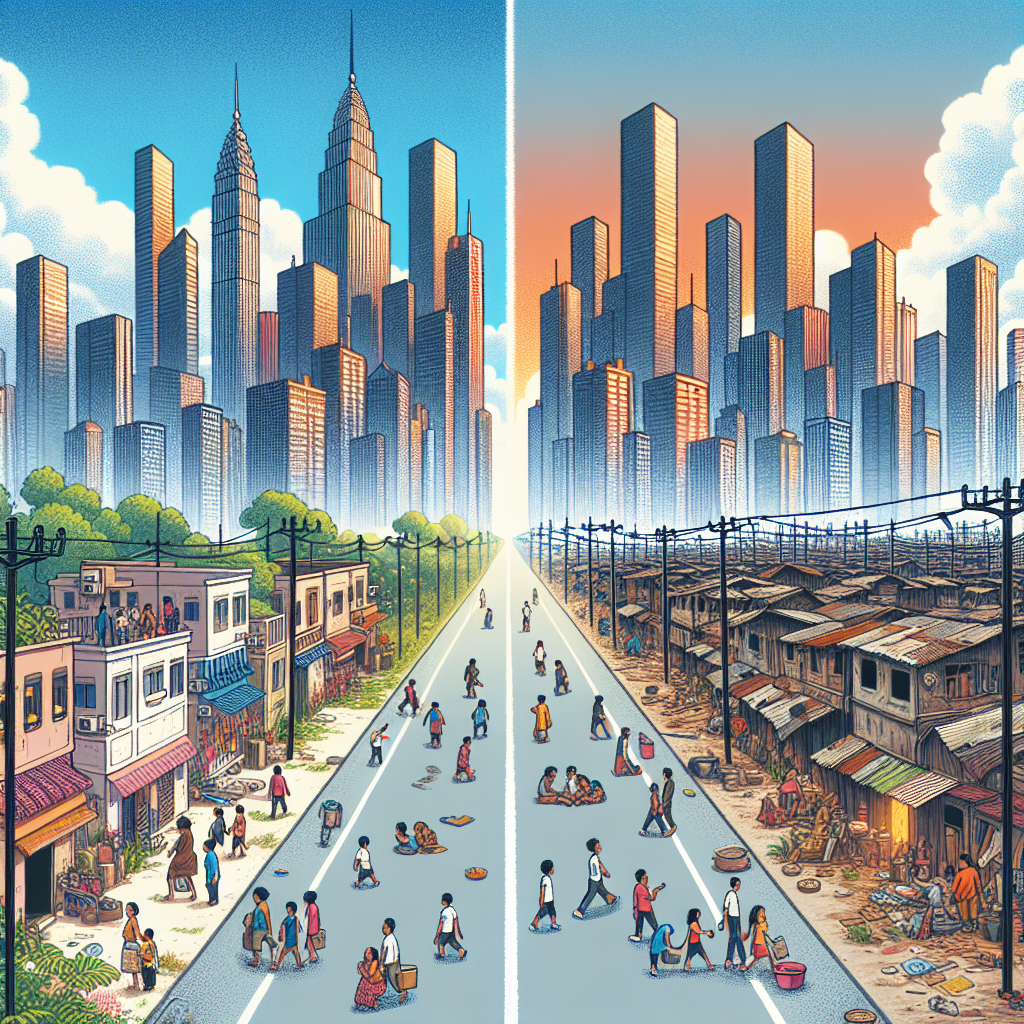Urbanisasi meningkatkan kesenjangan sosial dengan memperkuat divisi ekonomi, akses terbatas terhadap layanan dasar, dan meningkatkan segregasi sosial.
Dampak Urbanisasi Terhadap Kesenjangan Sosial
-
Table of Contents
- Introduction
- The Urbanization Trend in Indonesia
- Rural-Urban Migration
- Natural Population Growth
- Economic Development and Urban Expansion
- The Impact of Urbanization on Social Inequality
- 1. Housing Disparities
- 2. Unequal Access to Education
- 3. Limited Access to Healthcare
- 4. Income Inequality
- Addressing Social Inequality in Urban Areas
- 1. Affordable Housing Programs
- 2. Equalizing Educational Opportunities
- 3. Strengthening Healthcare Infrastructure
- 4. Promoting Inclusive Economic Growth
- Conclusion
Introduction

Urbanization is a global phenomenon that has been rapidly transforming societies around the world. In Indonesia, urbanization has been particularly significant, with millions of people migrating from rural areas to cities in search of better opportunities and a higher standard of living. While urbanization has brought about numerous benefits, such as improved infrastructure and access to services, it has also resulted in various social challenges. One of the most significant impacts of urbanization in Indonesia is the widening gap between the rich and the poor, leading to increased social inequality. This article will explore the consequences of urbanization on social inequality in Indonesia and discuss potential solutions to address this issue.
The Urbanization Trend in Indonesia
Indonesia has experienced rapid urbanization over the past few decades. According to the World Bank, the urban population in Indonesia has grown from 14% in 1960 to over 56% in 2020. This trend is expected to continue, with the urban population projected to reach 68% by 2050. The main drivers of urbanization in Indonesia include rural-urban migration, natural population growth, and the expansion of cities due to economic development.
Rural-Urban Migration
Rural-urban migration is a significant factor contributing to urbanization in Indonesia. Many people from rural areas are attracted to cities by the promise of better job opportunities, improved access to education and healthcare, and a higher standard of living. However, the influx of migrants into cities often exceeds the capacity of urban infrastructure and services, leading to overcrowding and increased competition for resources.
Natural Population Growth
Natural population growth, resulting from higher birth rates in urban areas compared to rural areas, also contributes to urbanization in Indonesia. As cities provide better healthcare facilities and a higher quality of life, families tend to have more children. This population growth puts additional pressure on urban infrastructure and services, exacerbating social inequality.
Economic Development and Urban Expansion
Economic development plays a crucial role in driving urbanization in Indonesia. As cities become centers of economic activity, people are drawn to urban areas in search of employment opportunities. This leads to the expansion of cities, as more land is converted for residential and commercial purposes. However, this expansion often occurs without proper planning and regulation, resulting in the development of informal settlements and slums, where the urban poor reside.
The Impact of Urbanization on Social Inequality
While urbanization has brought about economic growth and improved living conditions for some, it has also exacerbated social inequality in Indonesia. The following are some of the key ways in which urbanization has contributed to the widening gap between the rich and the poor:
1. Housing Disparities
As cities expand, the demand for housing increases, driving up property prices. This makes it increasingly difficult for low-income individuals and families to afford decent housing. Many urban poor are forced to live in informal settlements or slums, where they face inadequate access to basic services such as clean water, sanitation, and healthcare. The lack of affordable housing options perpetuates social inequality and hinders upward mobility for the urban poor.
2. Unequal Access to Education
Urban areas generally offer better educational opportunities compared to rural areas. However, the quality of education varies significantly between different urban neighborhoods. Wealthier neighborhoods often have better-funded schools with qualified teachers and modern facilities, while schools in low-income areas struggle with limited resources. This disparity in educational opportunities further widens the gap between the rich and the poor, as access to quality education is crucial for social mobility.
3. Limited Access to Healthcare
While urban areas generally have better healthcare facilities compared to rural areas, access to healthcare is not equal for all urban residents. Low-income individuals often face barriers such as high healthcare costs, limited health insurance coverage, and inadequate healthcare infrastructure in their neighborhoods. This results in disparities in health outcomes and perpetuates social inequality.
4. Income Inequality
Urbanization has led to an increase in income inequality in Indonesia. Cities offer more job opportunities, but these opportunities are often concentrated in specific sectors and industries. The urban poor, who lack the necessary skills and education, are left with limited employment options and are more likely to be engaged in informal and low-paying jobs. This income disparity further deepens social inequality and hampers social mobility.
Addressing Social Inequality in Urban Areas
To mitigate the negative impacts of urbanization on social inequality, it is crucial to implement targeted policies and interventions. The following are some potential solutions:
1. Affordable Housing Programs
The government should prioritize the development of affordable housing programs to ensure that low-income individuals and families have access to decent housing. This can be achieved through subsidies, rent control measures, and the promotion of public-private partnerships to increase the supply of affordable housing units.
2. Equalizing Educational Opportunities
Efforts should be made to improve the quality of education in low-income urban neighborhoods. This can be done by allocating more resources to schools in disadvantaged areas, providing additional support to students from low-income backgrounds, and implementing affirmative action policies to ensure equal access to quality education.
3. Strengthening Healthcare Infrastructure
Investments should be made to improve healthcare infrastructure in low-income urban neighborhoods. This includes increasing the number of healthcare facilities, ensuring the availability of essential medical supplies and equipment, and providing training and incentives for healthcare professionals to work in underserved areas. Additionally, expanding health insurance coverage and reducing out-of-pocket healthcare costs can help improve access to healthcare for the urban poor.
4. Promoting Inclusive Economic Growth
Efforts should be made to promote inclusive economic growth by diversifying the economy and creating more job opportunities in sectors that are accessible to the urban poor. This can be achieved through skills training programs, vocational education, and the promotion of small and medium-sized enterprises. Additionally, implementing minimum wage policies and ensuring compliance with labor laws can help reduce income inequality.
Conclusion
Urbanization in Indonesia has had a profound impact on social inequality. The rapid influx of people into cities has resulted in housing disparities, unequal access to education and healthcare, and income inequality. To address these challenges, it is crucial to implement targeted policies and interventions that focus on affordable housing, equalizing educational opportunities, strengthening healthcare infrastructure, and promoting inclusive economic growth. By addressing the social consequences of urbanization, Indonesia can strive towards a more equitable and inclusive society.







